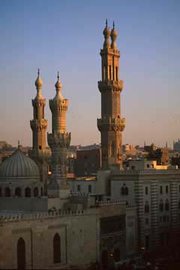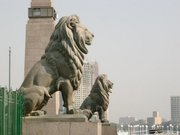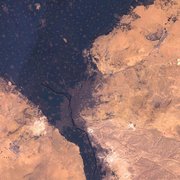Cairo
|
|
Cairo (Arabic: القاهرة; romanized: al-Qāhirah) is the capital city of Egypt and has a metropolitan area population of approximately 15.2 million people. Cairo is the thirteenth most populous metropolitan area in the world. Cairo is located at 30°2' North, 31°13' East (30.03333, 31.21667). [1] (http://earth-info.nga.mil/gns/html/cntry_files.html)
While al-Qāhirah is the official name of the city, in local speech it is typically called simply by the name of the country, Mişr (Arabic, مصر) pronounced Maşr in the local dialect.
The name Al-Qahirah litterally means "The Subduer," though it is often translated as "The Victorious." The origin of the name is said to come from the appearance of the planet Mars during the foundation of the city. The planet Mars, asssociated with destruction was called "Al Najm Al Qahir" in Arabic, from which the name of the city was derived. However the legacy of the name evolved into the title "Qahirat Al Adaa" meaning "subduer of the enemies". This title was given to the city as many armies were destroyed in attempts to invade Cairo or defeated elsewhere by troops sent from Cairo. (Mongols, Crusaders & Ottomans are examples)

| Contents |
Geography
ClimateCairoEgypt.PNG
Cairo_Egypt_ASA_IMG_Orbit_12013_20040617.jpg
Cairo is located on the banks and islands of the Nile River in the north of Egypt, immediately south of the point where the river leaves its desert-bound valley and breaks into three branches into the low-lying Nile Delta region.
The oldest part of the city is somewhat east of the river. There, the city gradually spreads west, engulfing the agricultural lands next to the Nile. These western areas, built on the model of Paris by Ismail the Magnificent in the mid-19th century, are marked by wide boulevards, public gardens, and open spaces. The older eastern section of the city is very different: having grown up haphazardly over the centuries it is filled with small lanes and crowded tenaments. While western Cairo is dominated by the government buildings and modern architecture, the eastern half is filled with hundreds of ancient mosques that act as landmarks.
Extensive water systems have also allowed the city to expand east into the desert. Bridges link the Nile islands of Gezira and Roda, where many government buildings are located and government officials live. Bridges also cross the Nile attaching the city to the suburbs of Giza and Imbabah (part of the Cairo conurbation).
West of Giza, in the desert, is part of the ancient necropolis of Memphis on the Giza plateau, with its three large pyramids, including the Great Pyramid of Giza (last surviving of the Seven Ancient Wonders of the World). Approximately 11 miles (18 km) to the south of modern Cairo is the site of the ancient Egyptian city of Memphis and adjoining necropolis of Saqqara. These cities were Cairo's ancient predecessors, when Cairo was still in this approximate geographical location.
History
Founding and early history

The current location of Cairo was too far from the ancient course of the Nile to support a city. Just to the south of the modern city's location are the ruins of Memphis, which was the capital of Ancient Egypt and was founded in around 3100 BC by Menes of Tanis after he had united the two kingdoms of Upper and Lower Egypt, although the capital later moved to Heliopolis, further south to Thebes, and, under the Ptolemaic dynasty, Alexandria.
The first settlement on the location of modern Cairo was a Roman fort, known as Babylon Fort, built about AD 150, built near the settlement known as Babylon-in-Egypt, which lay close to an ancient Egyptian canal from the Nile to the Red Sea.
A small town mostly of Coptic Christians slowly grew around the fort. Arab invaders, lead by Amr Ibn-el-As, took the fort town in 642 and also established their army in the location, rebuilding its defenses. The Arab tented camp outside the fortress, known as Al-Fustat, slowly became the permanent base of the Arab forces in Egypt under the Umayyads and Abbasids, and contains the first mosque in Africa.
Slowly, the settlement grew into a small city. The North African Shiite Fatimid Dynasty conquered Egypt in 972 and built a new capital, Al-Mansureya, north of the old settlement. Their leader, Al-Muez Ledin-Ellah, renamed the city Al-Qahirah after the planet Mars which was rising on the day the city was founded.
The Al-Azhar mosque was founded the same year, and along with its accompanying university it made Cairo a centre of learning and philosophy. The school remains a major center for Islamic study today. The Seljuks caputured Cairo in the mid 1100s, and Saladin and his successors expanded the city further, including the construction of its massive citadel.
The sack of Baghdad in 1258 heightened the importance of the city and it became the leading intellectual and artistic centre in the Middle East, and perhaps the world, for the next 250 years. But power was shifting from the Arab world north to the Turks and Europeans.
The city was taken by the Ottoman Empire under Selim in 1517, but the ruling Mameluks quickly returned to power as nominal vassals to the Ottoman Sultan.
Era of westernization

Napoleon conquered Egypt in 1798, and Cairo was quickly surrendered to him by its Mameluk rulers. Napoleon left Egypt after his fleet was destroyed at the Battle of Aboukir Bay in August 1798, leaving General Kl颥r in charge. Kl颥r was assassinated in 1800 and the three-year French occupation had little lasting effect.
The first hints of westernization began under the successors to Mehemet Ali with the introduction of a railway connection to Alexandria in 1851. Significant change, however, did not occur until the reign of Isma'il Pasha when, in 1863, construction of the Suez Canal brought significant numbers of westerners to Egypt. A network of gas lighting was installed by a French company and the railway lines were greatly expanded.
In 1867, Isma'il visited Paris to attend the Universal Exposition of 1867. There he saw the newly redesigned city of Haussmann and, funded by a booming cotton trade, decided to rebuild Cairo on the model of a European capital. He hoped to have this done by 1869 when representatives from around the world came to Egypt for the opening of the Suez Canal.
Rather than rebuild the old city, Isma'il elected to add a new quarter to the western section along the bank of the Nile. The project was carried out by Ali Pasha Mubarak and designed by the French urban planner Pierre Grand. A new area of luxurious villas and apartments was constructed and new government ministries were erected. Grand boulevards were opened through the old town and tram lines soon followed.
The era of colonization in 1882 saw the rebuilding of Cairo continuing. A modern sewer system was installed and new suburbs such as Heliopolis were constructed in the desert. Cairo's population exploded, increasing from 374,000 in 1882 to 1,312,000 by 1937. The city was dominated by westerners, however, and city planners tended to emphasize Christian cathedrals over mosques.
Modern Cairo
CentralCairo.JPG
Sep13503.JPG
Cairo remained the central city of Egypt throughout the period of British rule and afterwards. The 20th century saw massive growth in the size of the city as peasants left the farmlands in pursuit of work in the factories and commerce of the metropolis. The city was especially burdened by refugees from the various wars with Israel: much of the population of the Sinai peninsula and the cities along the Suez Canal left for Cairo between 1967 and 1978.
Today Cairo is Africa's most populous city and the Arab world's cultural centre.
Since the 19th century Cairo has also become a center for tourism as people from around the world have come to see the monuments and artifacts of Ancient Egypt, especially the Pyramids. Laws against the export of these treasures has meant that the Egyptian Museum in Cairo is the only place in the world that many items can be seen.
Transportation
Cairo-Hilton-Skyline.jpg
Cairo1.jpg
Egypt.Cairo.Tram.01.jpg
Rail
Cairo stands at the hub of Egypt's 5000 km railway network. Ramses Station in central Cairo interconnects the main southward-bound line up the Nile valley (serving Assyut, Luxor, and Aswan) with the different lines that fan out across Lower Egypt and service the main cities of the Delta region (including Alexandria, Ismailia, and Port Said).
A second mainline station is located some 10 km south, at Giza.
Road
Cairo's roads are amongst the most dangerous in the world. The death rate per kilometre traveled in Egypt is over 40 times as high as the European average and twice as high as the nearest comparable Middle Eastern country. But thanks to often deadlocked traffic, car crashes are rare, and when they do happen, they are almost always non-fatal.
Metro
Main article: Cairo Metro
The Cairo Metro is Africa's only fully-fledged metro system. Two lines cover a total of 62 km, with another four lines in the planning stages.
Tram
Cairo's first tram line was constructed in 1898. That tram was the first north-south public transportation route in Cairo. It went over Khalij Misr, an ancient canal that leads to the Red Sea.
The tram network has been largely dismantled in recent years and few lines now remain operational outside the northern suburbs around Heliopolis.
Buildings and constructions
Cairo in art, literature and music
- Naguib Mahfouz
- Cairo Opera House [2] (http://www.operahouse.gov.eg/)
Famous Cairenes
- Boutros Boutros Ghali, former Secretary-General of the United Nations, was born in Cairo.
- Maimonides, famous Talmudic scholar.
Town twinning/Sister cities


